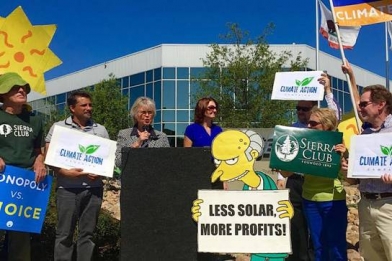
Protesters denounce SDG&E appeal over net metering; SDG&E defends its actions
Originally Published on the ECOreport
By Roy L Hales
March 18, 2016 (San Diego) -- There were about 150 protesters on Wednesday, chanting “We will fight corporate greed,” “how do you spell corporate greed? SDG&E” and “solar power is what we need.”
Some wore T-shirts boasting of affiliations to environmental groups like the Sierra Club or San Diego 350.org. Others were from local installers like Sullivan Solar Power, Stellar Solar, or SolarCity. The principal speaker was County Supervisor Dianne Jacob, who has long championed rooftop solar. They were outside SDG&E’s corporate headquarters, in response to the utility’s appeal of the California Public Utilities Commission’s decision to leave the current Net Energy Metering (NEM) program in place. This it how the San Diego Solar Community responds to SDG&E.
San Diego’s Solar Community Responds To SDG&E
“We’re here today to deliver a message loud and clear: SDG&E, back off!” began County Supervisor Dianne Jacob.
“The solar business is booming. It’s now a $1 billion industry in San Diego County. It employs more than 8,000 people in our region. Rooftop solar is coming to neighborhoods all across sunny San Diego.
“But SDG&E is out to kill it. It wants the state to gut ratepayer incentives that encourage rooftop solar. It’s asking the state Public Utilities Commission to revise its recent decision to keep net metering in place.
“SDG&E wants state regulators to make what it calls 'modifications.' I call it more of the same from a monopoly that has gouged consumers for decades.”
Overpaid Executives
In the speech that followed she referred to SDG&E’s “overpaid executives.”
According to the Utility Reform Network, the CPUC allows SDG&E executives to collect “about $35 million per year for executive bonuses, on top of the six and seven figure salaries” and other benefits.
As for SDG&E’s revenues, the most recent annual filing (10-K) shows they have increased from $404 million in 2013 to $587 million in 2015.1 A large chunk of this increase ($119 million) is connected to the closure of the San Onofre Nuclear Generation Station, of which SDG&E was part owner. Only $26 million was the direct result of a rate increase.
The Rally
SDG&E employees quietly observed the rally from across the street.
There were also “lots of police cars” on hand, in case the situation got ugly.
“But the rally was not confrontational at all, said Nicole Capretz, founder and President of the non-profit organization Climate Action Campaign.
She was there to protect rooftop solar and said it was important to be on SDG&E’s turf, letting them know what solar means to the broader community.
Solar Customers Should Pay For Their Transmission Costs
A company spokesperson, Amber Albrecht, explained SDG&E’s position. “The way it stands right now, those who cannot afford rooftop solar will pay an extra $300 on their utility bills, by 2025, to support the solar industry,” she told ECO Report. “The main modification we are asking for, right now, is that solar customers pay for the transmission of all the energy that they use from SDG&E. That was actually included in the proposed decision and then striped out less than 24 hours before the (CPUC) vote.”
During the course of our subsequent conversation, she added, “This is the only thing we have asked for. We haven’t asked them to go back to the drawing board. We’ve recognized that this decision says they will go back and look at this issue in 2019, so instead we focused on this modification to add back in.”
What Is the Balance?
Nicole Capretz, founder and President of the non-profit organization Climate Action Campaign, believes, “There is a host of benefits that the utility and the community and the grid receives when you put solar energy onto the grid. So it is a balancing act and that is what the PUC was charged with determining. What is that balance and how do you continue a program that makes sense for everybody considering everything, which includes the environmental and economic benefits included in the net metering program?”
“We have taken that into account, but we have also taken into account what this means for customers who cannot afford solar. They may be a renter who cannot accommodate solar on a roof. or their roof just isn’t in the right area to accommodate solar panels,” said Albrecht.
She added, “When the CPUC voted on this issue, there were actually two Commissioners who voted no. One of these being Commissioner Florio, and when he made his vote he said, ‘Any system which benefits the few at the cost of the many can only be sustained for so long.”
(CPUC President Michael Picker, one of the three Commissioners who voted to let the NEM remain in place, issued a press release stating, “Our course is not for the rooftop solar industry or for the utilities or the community clean energy aggregators. Our decision today is another big step toward giving California consumers more choice, more control, and more responsibility over energy and climate change issues. It’s a big step, but it’s only one of many.”)
Fossil Fuels vs Solar Energy
SDG&E has always insisted that it is working with solar and in a press release, sent out later that day, stated, “SDG&E believes that creating a solar rooftop program that adds value for all customers should be a top priority. To date, more than 82,000 SDG&E’s customers have installed solar, many doing so with the aid of SDG&E innovations that help to make the process safer, quicker, and more affordable. The company will continue its efforts to make solar more accessible and affordable for all customers.”
However, Tara King, of Sullivan Solar Power, says San Diego Gas and Electric’s (SDG&E) “antiquated business model” is built around fossil fuels:
“They don’t want to see a solar energy revolution in California. They want us addicted to their toxic and polluting fossil fuels. They want to build more power plants in your backyard. They want to continue to pay their executives ungodly salaries and post record profits.
“And this is why they are continuing to use ratepayers’ money to pay an army of lobbyists and lawyers to bully state regulators to make going solar more expensive. Their motives are clear – they want more money. They want to shut down clean energy and use their monopoly status to stifle competition. This is why we are here today, to tell SDG&E that enough is enough.”
Best Interest of Rate Payers?
"As it lobbies the state for 'modifications,' SDG&E says it is doing this in the “best interest” of its customers. Since when… does SDG&E… do things… in the best interest of customers?” Superintendent Jacob told the crowd.
"This is a company that wants to stick ratepayers with the cost of decommissioning San Onofre. This is a company that wants ratepayers to cover costs related to our massive wildfires in 2007 – wildfires that were caused by SDG&E’s own equipment! This is a company that now wants to gut net metering. This would rob ratepayers of financial incentives that have helped grow our solar industry, grow our economy. Shame on SDG&E. Shame on it for always putting its shareholders first. Shame on it for shaking down ratepayers and then claiming it’s looking after our interests.”











Comments
SDG&E
The company has a record of anti-consumer and environment actions, like the Costa Azul LNG plant debacle.
Nature destroying, industrial
Nature destroying, industrial scale solar and wind farms mandated by state and federal authorities are failing by nearly every criteria.
http://www.powerlineblog.com/archives/2016/03/the-great-solar-epic-fail-...
http://www.sandiegolovesgreen.com/octotillo-where-is-the-wind/